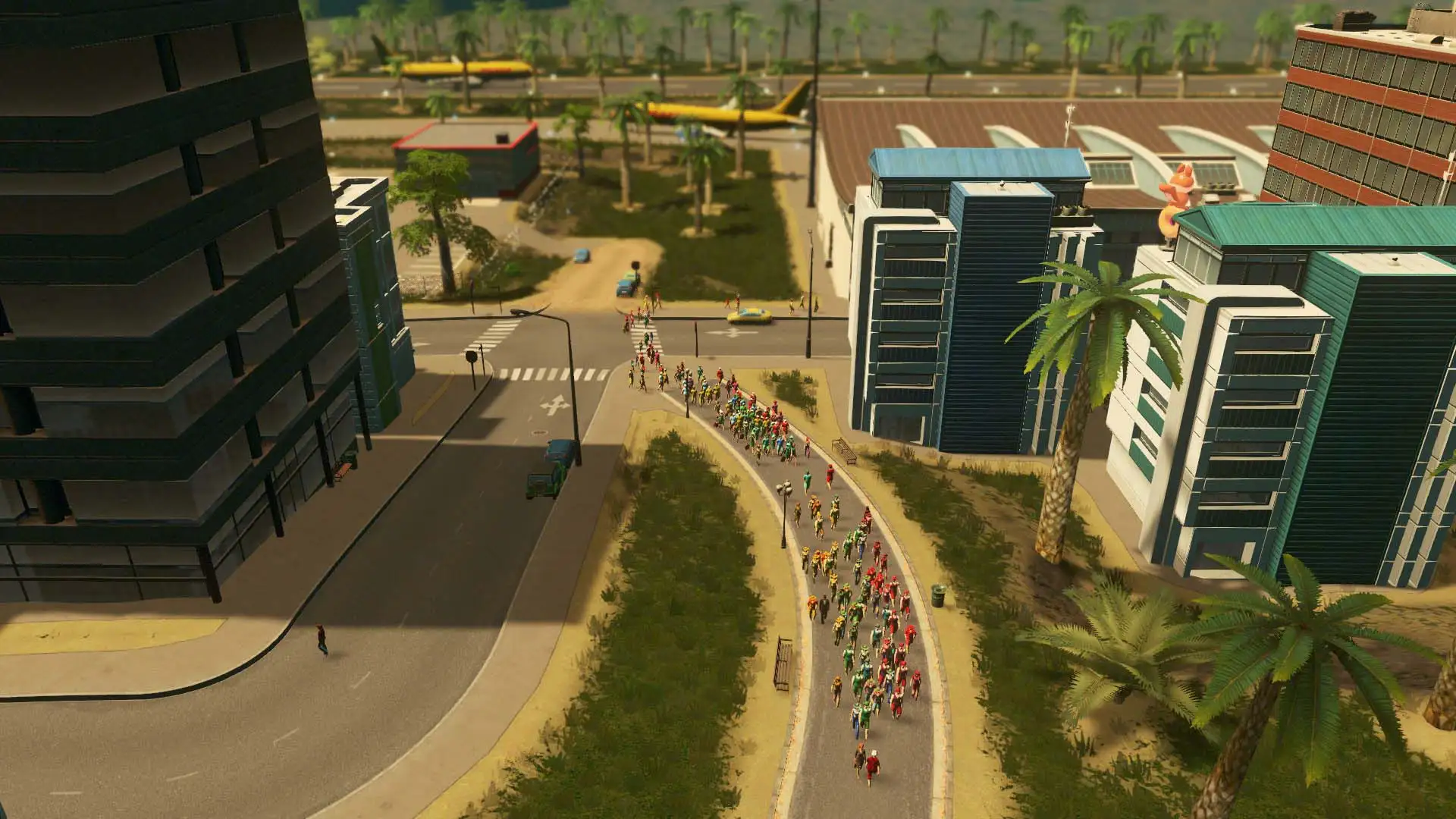
The dream! Hundreds of tourists pouring into the city from the airport or harbour, about to catch the train into the centre, ready to spend their money.
I love building a city that thrives on tourism.
There’s just something about the idea of hundreds of eager visitors stepping off the plane, train or ship and being welcomed into my city’s open arms that appeals to me.
In Civilization V, I’d always find myself going for the cultural victory (which was overhauled and fleshed out in the amazing Brave New World expansion). I loved winning with huge, gleaming cities, packed with monuments, museums, famous art and the best concerts.
Admittedly, there was also something satisfying about seeing other civilisations taking the ideological paths of Order or Autocracy. In the face of my cultural power, they’d be immediately consumed in the flames of civil revolt. Citizens took their streets demanding to ‘wear my blue jeans and listen to my pop music’.
Anyway. I guess that’s why I’m always drawn to tourism in my Cities: Skylines cities. Even when the city is ‘about’ something else, like creating an end-to-day supply chain, or being very green, I work on ways to bring more tourists in.
I was a latecomer to Cities: Skylines, but I instantly fell in love with it. In this article, I’m going to answer some of the questions I had when I started learning the game. I hope it helps!
Just a note on compatibility: I’m talking about the vanilla, unmodded game here, so it applies across PC, Xbox, PS4 and Mac versions. I talk about stuff in the After Dark, Mass Transit and Parklife expansions. If you want to get those and support this page at the same time, you can grab on them Humble Bundle here, here and here, or from the links in the text. Thank you!
How does tourism work?
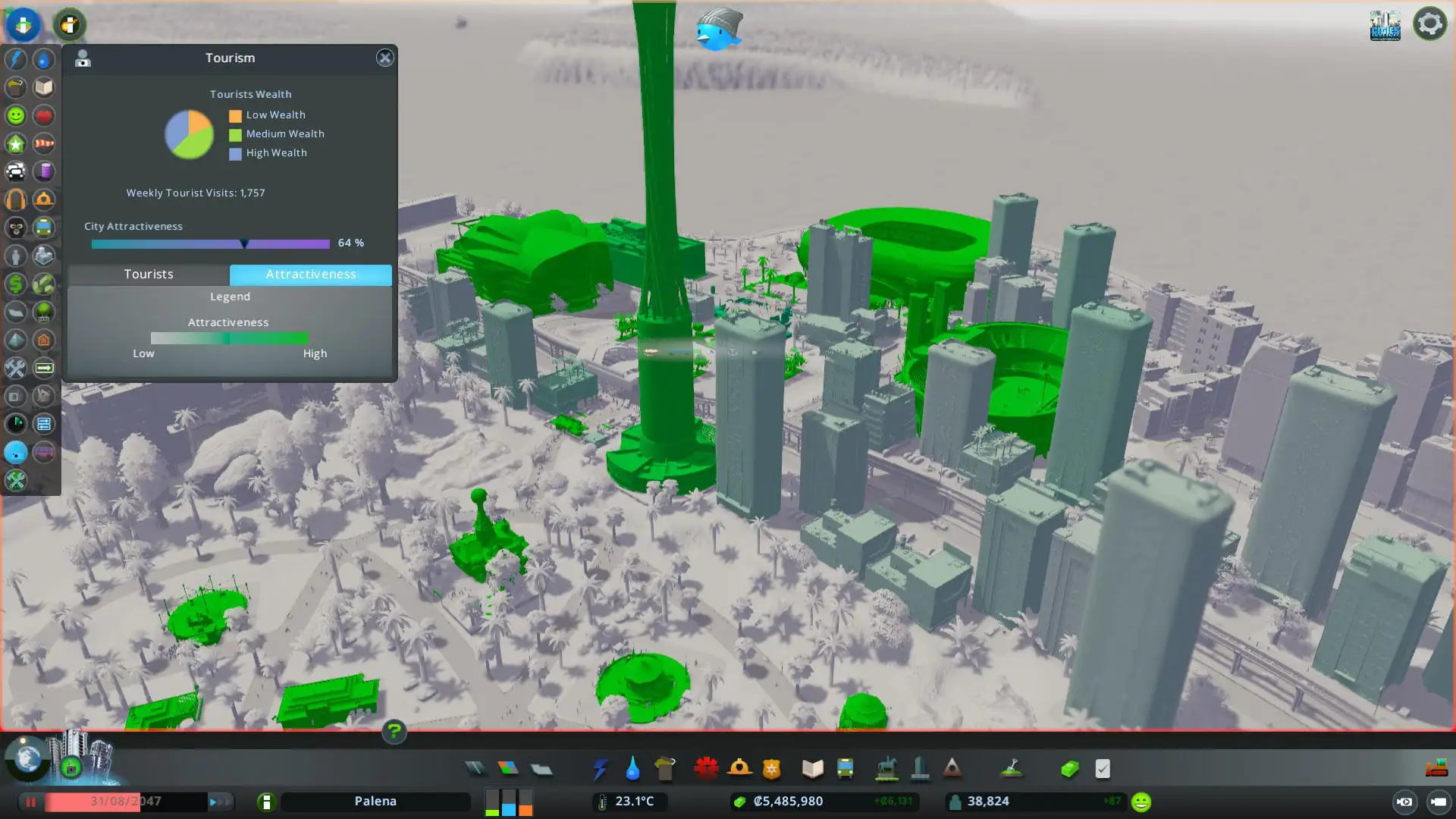
This overlay shows how strongly each building pulls tourists to the city. Amusement park buildings and uniques like the Stadium and Expo Centre are great. Tourism specialised commercial districts, in pale green, also contribute.
In Cities: Skylines, people from other cities can come and visit yours. Cims can arrive by road, rail, water, air and even space to have a look around. They enjoy your parks, visit your cultural centres, play sports or just soak up the nightlife.
The quickest way to see how you’re doing as a tourist destination is to open the City Information panel; click the ‘i’ at the bottom left of the UI. There, you’ll see how many tourists visited last week, and more importantly, your city’s attractiveness. That measure increases as you add unique buildings and things to see.
You can dig a little deeper by opening the Tourist information panel. There you’ll see how wealthy your visitors are, and there’s a couple of overlay tabs. The first, ‘Tourists’, shows you physically where your tourists are right now (and how many, indicated by a deepening shade of purple). Zoom in to see trains, buses, trams, cars and buildings shaded if they contain tourists.
The second tab shows which buildings are contributing to the city’s overall attractiveness. Although tourists do visit your smaller attractions like your new jet ski rental place (and they also pop into to commercial buildings like hotels and shops), the green stuff shows you what really dragged them here in the first place.
Early on, all your tourists will arrive by car. As you expand the map and pass population milestones, you’ll be able to connect to outside lines that bring in tourists on public transport. Visitors will arrive on regional trains, cruise ships, and planes, for which you’ll build train stations, harbours and airports. It’s worth pointing out that not all maps have all outside connections. On the map selection screen, you can see what’s available before loading in.
Now, it’s not completely clear whether adding new ways for tourists to visit means more tourists by itself. It’s possible city attractiveness is the only determiner of how many come along. If you’ve got any data on that, I’d love to see it! Either way, adding entry and exit points gives you more control over how tourists move around. That has the double benefit of controlling traffic and getting them on your public transport.
How do I boost the numbers of tourists?
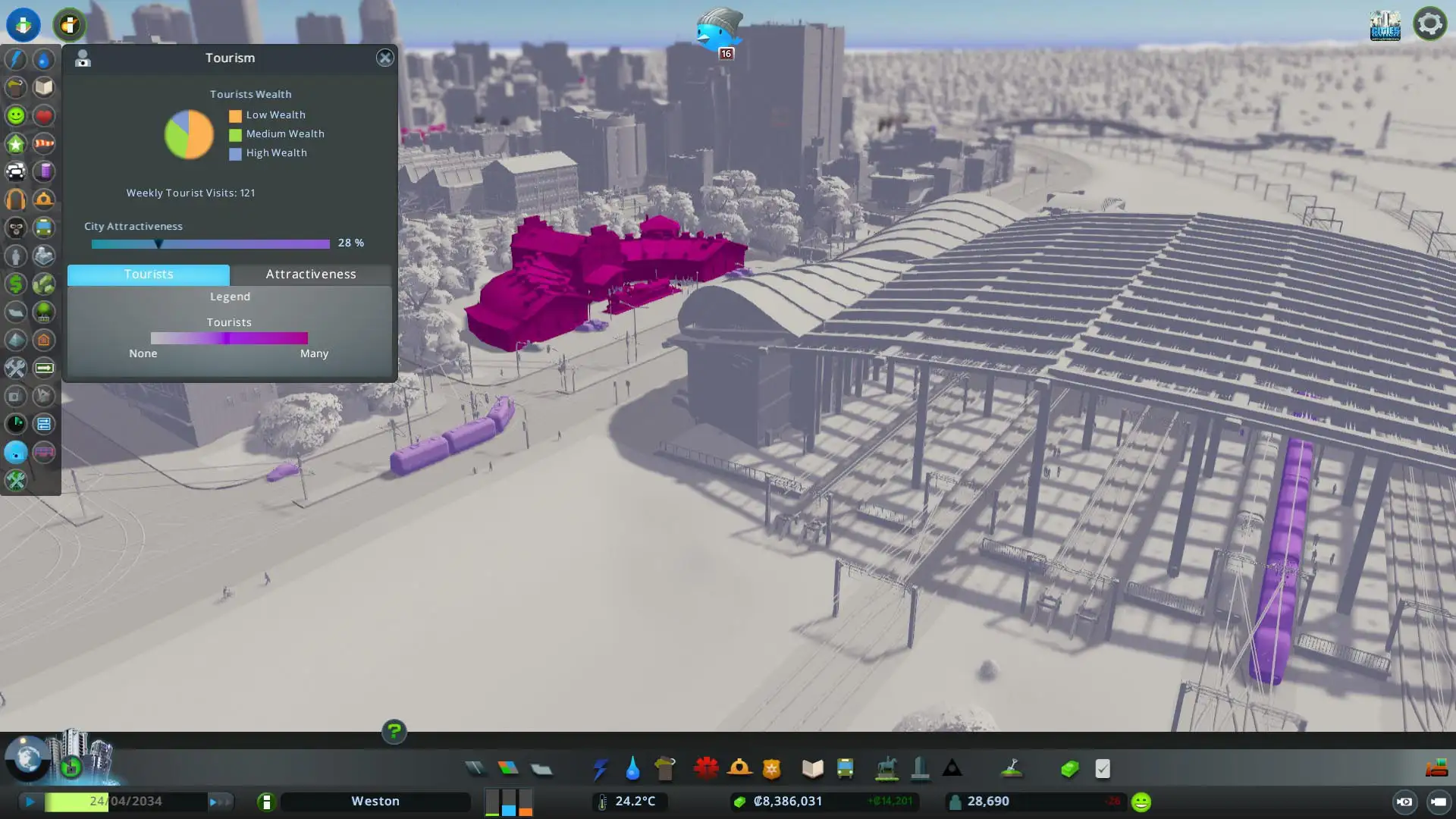
You can see where your tourists physically are right now. There’s quite a few visiting the Locomotive Halls museum, some on the tram, some on the train - but none (if you closely) on the white train next to the purple one.
The main answer is, of course, to build. Build tourism-specialised commercial districts, unique buildings, landmarks, and the new Parklife park districts. Construct an enormous amusement park with two of every building and watch them flock to your city!
The more of that stuff you build, the higher the city’s attractiveness climbs, and the more tourists arrive. Land value seems to be a factor, so the small parks and plazas you place around the place also contribute. But there’s other things you can do, too.
The Parklife monument, Castle of Lord Chirpwick (which looks awesome, for an appropriately styled city) gives a hefty 100 attractiveness boost for the entire city. That’s like giving everyone an extra park in their neighbourhood. Also, every unique building gets a 25% attractiveness boost, pushes up your attractiveness significantly. It does cost almost 2 million to build, but its upkeep is a surprisingly reasonable 3,200 a week.
Elsewhere, there’s a few City Policies you can use to your advantage. Boost Connections, under City Planning, is the most obvious. For 10,000 a week, all your outside connections will get 20% extra capacity, letting (hopefully) a flood of new tourists arrive.
Let Go of Leisure, under Taxation, is another good one. In exchange for taking no tax revenue from commercial districts specialised as Leisure, you get a big boost in the attractiveness of those districts. It’s hard to know if that’ll pay off financially, but it’ll certainly drag new people in. Similarly, Recreational Use legalises previously banned substances, increasing tourism in exchange for 15% higher police budget.
You can also give your parks a boost with Prefer Parks. In exchange for 100 a week in upkeep (per park), 10% more tourists will visit them instead of unique buildings. I’m not clear if that means you can have 10% fewer unique buildings in your city though…
The other one that helps a bit is Park Maintenance Boost. If you’re using the Park Maintenance Building, it will become 50% more effective, giving all your Parklife expansion Parks more attractiveness.
It’s worth saying that these policies can be set city-wide or by district, allowing you finer control. Each Parklife park also has its own set of policies that can boost its attractiveness (or not, for local parks you aren’t trying to promote).
The Tourism specialisation
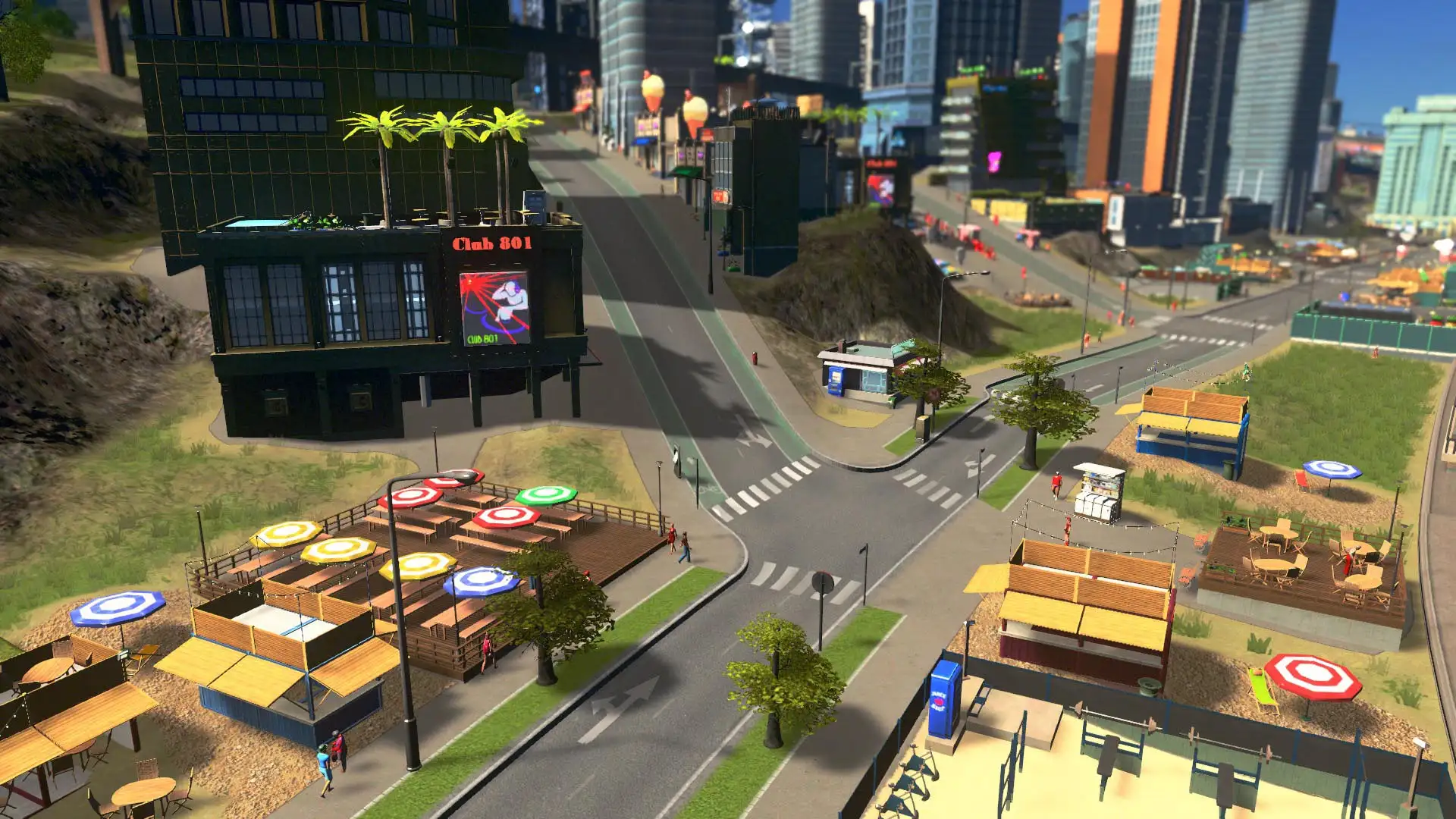
Some of the tourism specialisation buildings. The ones on the waterfront automatically become cafes and open-air businesses, which is great.
The After Dark expansion added the ability to specialise your commercial districts for tourism. When you do that, you’ll see hotels, restaurants, souvenir shops and cafes begin to pop up.
The district brings in more tax revenue than a standard commercial district, along with a little more crime. A tourism district is also very loud, so don’t put it near any residential areas or your poor cims will get sick.
Pull up the tourism overlay, you’ll see the main mechanical benefit of the tourism district. It has a pull factor for tourists shown by the pink shade of most of the buildings. Each square is contributing to your city’s attractiveness and encouraging tourists to come and visit. What’s nice is you avoid the huge upkeep costs of some of the landmark buildings.
Of course, though, who cares about mechanical benefits if it doesn’t also look great? Adding tourism areas can bring parts of your city to life, with appropriate-looking buildings for your waterfront, near your amusement park, and around some of the key unique buildings that tourists would want to visit. It also means you can give some nice variety to your city. Mix up low- and high-density generic commercial, leisure, organic (if you picked up Green Cities) and tourist areas to avoid homogeneity.
By the way, when you add a specialisation to a district, the buildings inside the district don’t just ‘specialise’… they disappear. New buildings spawn from scratch! Because most specialisations only have a single level, you won’t need to wait for them to upgrade, but if your demand for that type of zone is low, it might take a long time for the area to fill up again. In the meantime, you have a hit on employment, taxes and tourism. If that’s going to be a problem, you can do it progressively, expanding the district over time.
The economics of tourism - is it profitable?

This is going to go really, really high. Eventually.
Honestly, I don’t know. It absolutely does bring in a lot of money. A 40,000 population archipelago city of mine brings in around 16,000 (dollars, credits, units, money?) a week. That’s split between public transport, my parks, and my commercial areas.
On top of that, the tourism districts pay a bit more tax than normal, and they provide jobs that I’d need to provide anyway. Also, the stadium (from the great - and free - Match Day DLC) is very attractive for tourists, and more visitors means more chance of winning the substantial prize money.
That said, entry points like the airport cost a fortune, and the upkeep of some of the buildings is exorbitant. There’s also the chance I’ve added transit lines and interchanges I might not have bothered with otherwise.
Ultimately though, running a budget surplus in the game isn’t a huge challenge, so it probably doesn’t matter. If building an internationally renowned tourism destination is your thing (and it is mine), it’s more than possible.
Doing your master planning
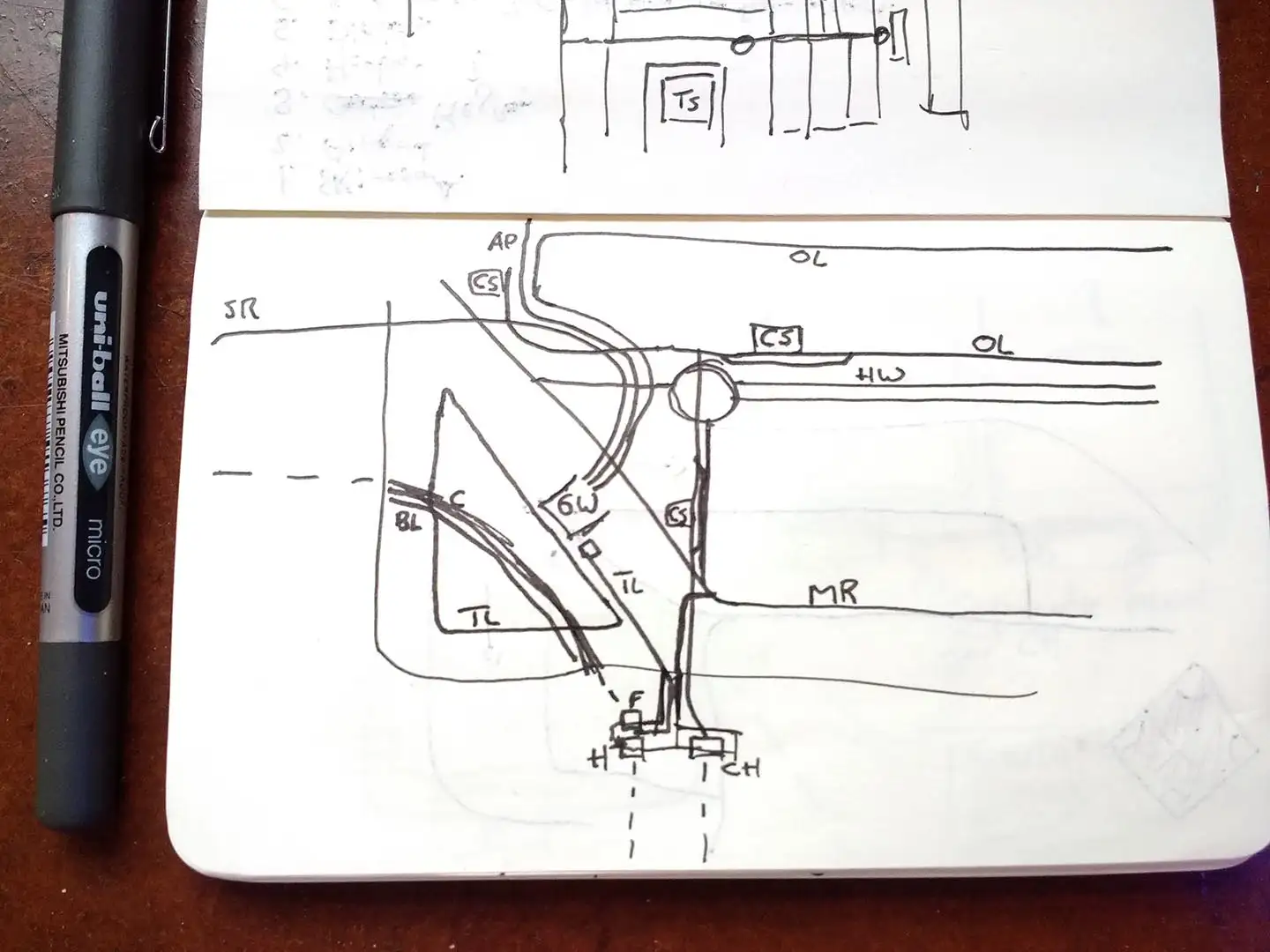
A better use of your time than whatever you were doing: working out how you’ll get all your lines in and out with minimal crossover.
Although even your smallest playgrounds attract tourists (which I think is a bit weird - who travels to another city to see an $8/week ‘Small Park’), most tourists are here to see your big hitters: the entertainment complexes, parks, sports venues and concert grounds.
It’s a good idea to think ahead about where your tourism areas are going to be. Most strategies are viable. One massive downtown-type area works, fed by high-capacity transit lines. You could opt to spread your attractions evenly throughout the city, putting no undue stress on any area.
The other way is to design smaller centres based around a handful of key buildings. That probably feels a bit more ‘right’ - and has the advantage of letting you put areas within easy reach of your city’s main entry points like the airport and harbour.
If you go that way, you could put your amusement park, casino and hotel uniques together, surrounded by leisure and tourism districts. Somewhere else, you could go for a beachfront feel based around all the marina-type buildings and perhaps a busy ferry line. In a greener area, maybe a campus district that serves university education to your citizens, complemented by tourist-trap landmarks. The Observatory, Climate Research Station and stuff like the Tax Office, Oppression Office and Amsterdam Palace make it look real.
Designing your public transport
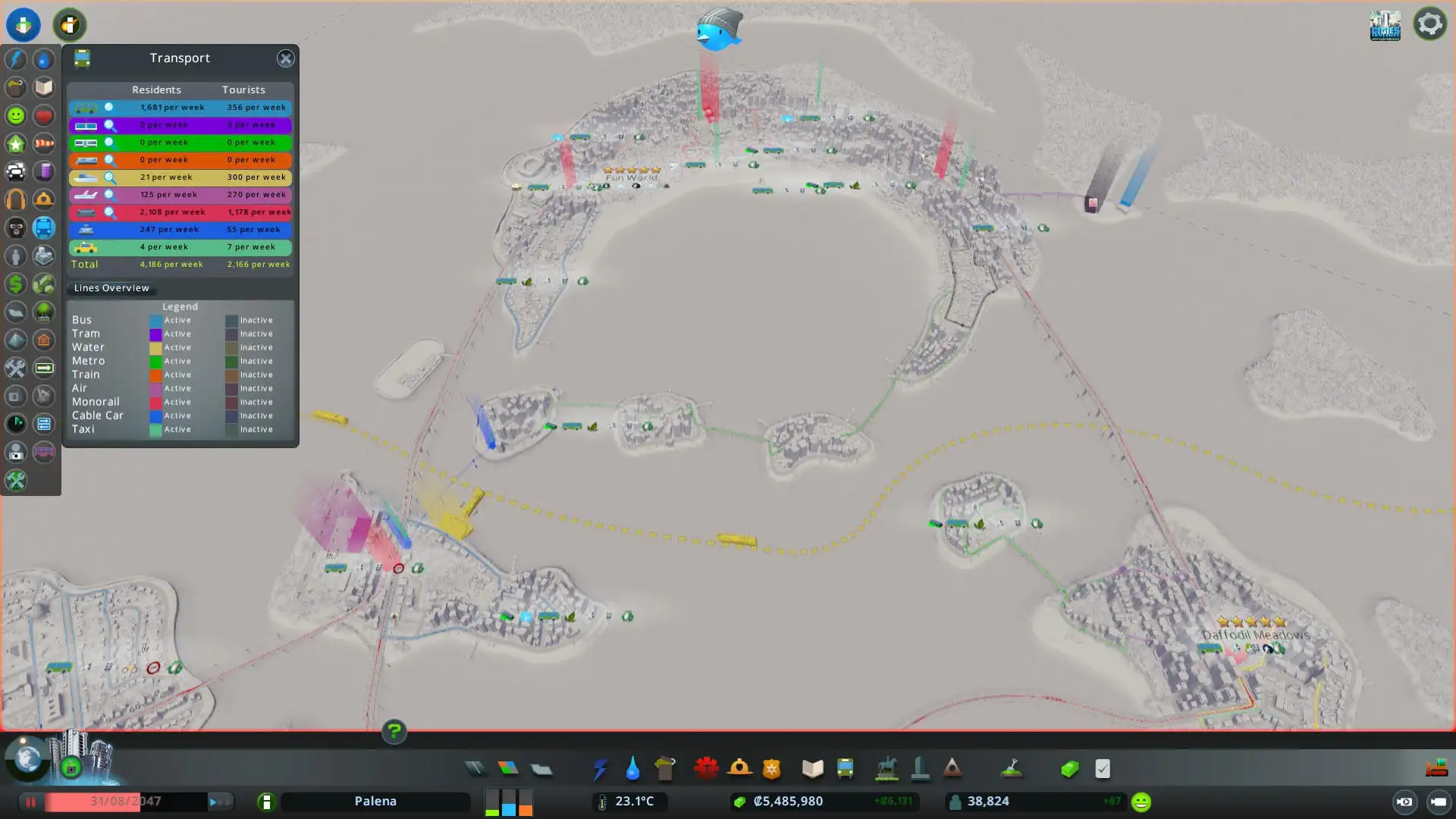
This isn’t a great screenshot, but here’s the general idea: airport and harbour bringing people in on the clockwise loop of the monorail, residents mainly coming on the counter-clockwise loop to maximise utilisation on existing lines.
Early on, the measly handful of people visiting your city will arrive in their cars via the highway, but as your city grows new options will open up.
From a flavour point of view, having your tourists arrive through major hubs like the airport and harbour just feels great. You see them all pile out of the front door before (ideally) hopping onto the next monorail that zooms them into the city. But in terms of traffic management, it’s also much better to have tourists leave their cars at home. Your roads deal with a huge amount of cargo traffic, and dozens of visitors in their cars can easily ruin key intersections.
By bringing them into a hub building, you can control how they move around and leave. But it’s important to put these things in the right place. Looking down at your future tourist megalopolis, it doesn’t make sense to have (left to right) airport/harbour, residential, tourist district. Your trains will arrive in the residential area already busy, and be half-empty on the way back.
Instead, it’s better to lengthen existing lines, so they reach out to transit hubs on the other side and give a purpose to the often less used carriages heading back to the residential areas. That way, you can increase utilisation without needing to add too much extra capacity.
In my archipelago city, for example, I fulfilled a geeky dream of having monorail as the primary, very profitable and extensively used transit method. It formed a complete loop of the city, passing through various islands. If we say the commercial centre of the city was in the middle, most of the residents arrived on the monorail from the right, and I put my airport and harbour on the left. That increased utilisation of the clockwise looping line which was otherwise pretty quiet.
Keeping your lines separate
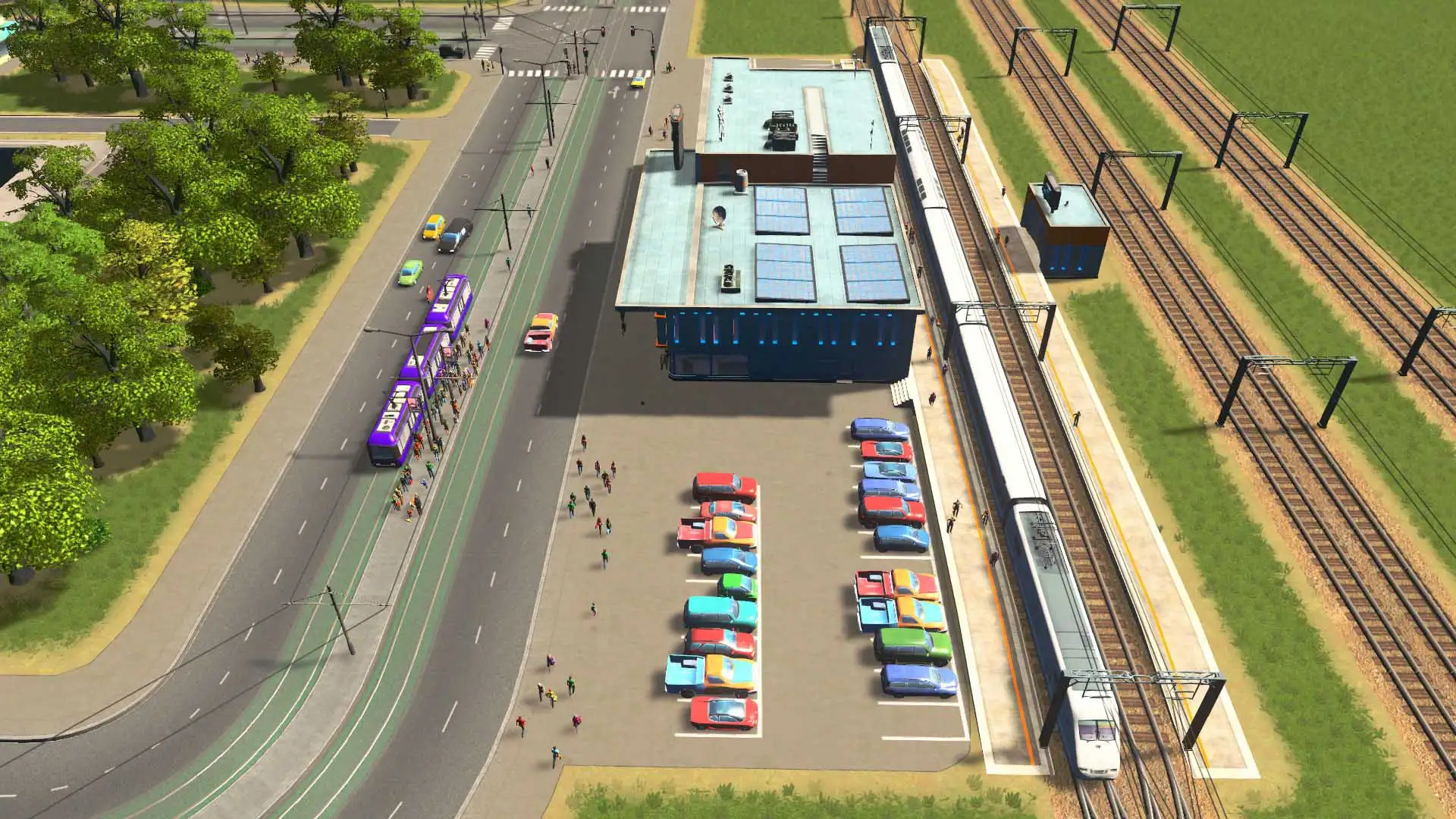
A district line going to all stations, an express line just going hub to hub, and an outside line for tourists, dropping off only at stations where they have a dedicated line where they won’t back up internal lines.
Just like in real life, residents in your city can have their daily life disrupted by an abundance of tourists. That’s why it’s a good idea to separate your transit lines or at least balance the city to avoid congestion.
Even once you’ve built a harbour and airport, a lot of tourists will want to come in by train. If you’ve got the space, build a separate track specifically for outside line trains that only stop at your tourist hub. If you let them act as local trains, they’ll clog up lines and junctions by stopping everywhere. It’s infuriating when do that and only drop off three people. It’s much better to have them drop off all tourists in one place; those people can then join your local lines to get where they’re going.
If you haven’t got the space or budget to run separate lines, you can at least uncheck ‘Allow Intercity Trains’ so that they pass quickly through your district stations on their way into town.
Is it worth building multiple transit hubs?
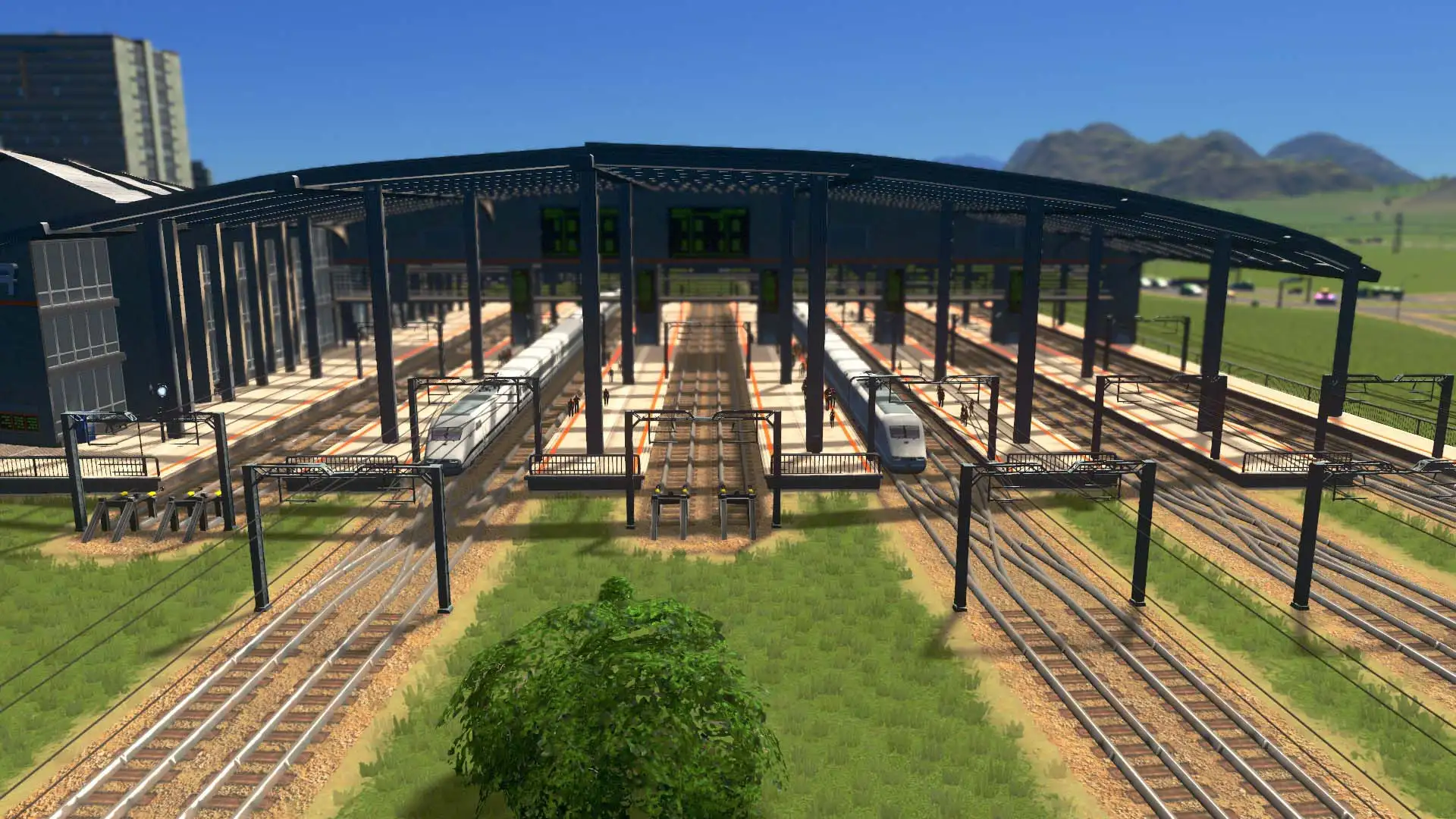
I love the transit hub buildings. Having people switch from train to metro, to whatever is just so… satisfying. But you probably don’t need multiple airports.
If you’re building a truly huge city, you might find that building multiple transit hubs is worthwhile. Harbours at different ends of your waterfront or airports on opposite ends of the map might work. That increases capacity and spreads people out, lightening the load on your key transit routes a bit.
In most cases, though, it’s not really worth it, for a couple of reasons. First, it takes a vast amount of traffic before you’ll see the harbour and airports begin backing up. They’ve got a lot more capacity than you’d expect. The harbour can handle ships overlapping with each other, and although you do start to see planes in the standard airport sometimes queue, the delays are normally minor. Also, they apply to leaving, so who cares!
Second, tourists will usually stick to whatever is quickest or closest to their destination. Put two harbours close to each other, and the ships won’t split - they’ll just go to the nearest one. And since those buildings, especially the airport, are so expensive, they won’t come close to breaking even unless they’re getting close to capacity.
When it comes to trains, you’ve got a bit more flexibility. If you’re able to dedicate one line on hub stations to outside lines, regional trains can drop passengers in several places. If you’ve already got the station in place anyway, you’re not adding any upkeep cost, so it works out.
The Space Elevator
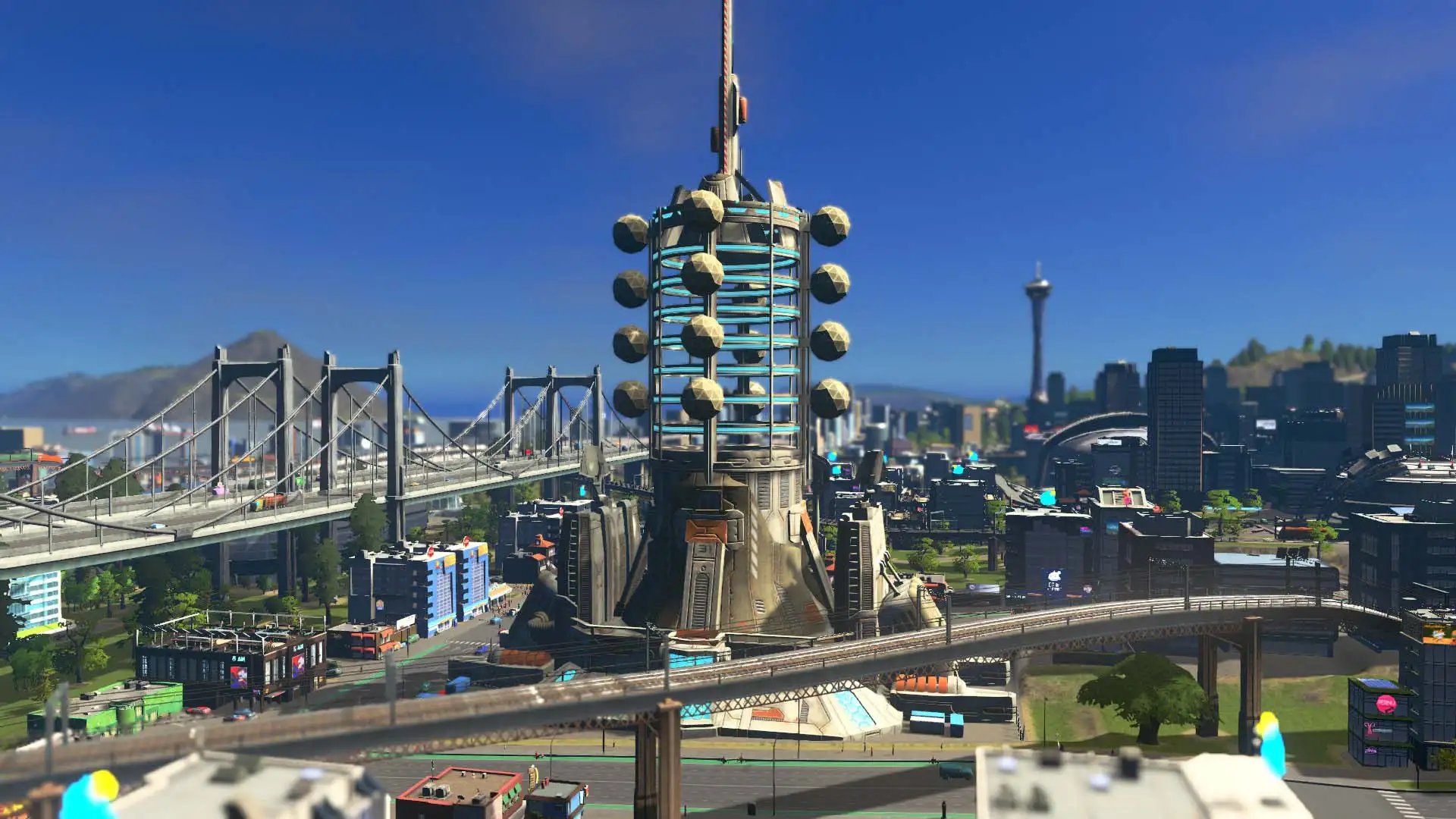
The Space Elevator. How does it work? Who knows.
One of the ‘end-game’ buildings, the Space Elevator is a huge, noisy monument that boosts tourism. You need to unlock and build six of the unique buildings to get access to it. It costs 1.5 million to build and was the first monument I unlocked through normal gameplay. Be careful not just to whack it down though - at 16,000 a week, its upkeep will put a nice dent in your budget.
Of the five monuments in the base game, it’s a bit of weird one. Whereas the other four essentially ‘fix’ something like providing all your energy, the Space Elevator instead brings ‘a lot’ of tourists to your city.
Now, I’m not certain if it simply attracts tourists who arrive in the usual way - like a mega landmark - or if it spawns tourists who literally arrive from space. In the Elevator.
Thematically, the one time I used it, I preferred to think of it like the Space Mountain ride in Disneyland. Otherwise, it just feels a bit ridiculous. On a side note, I don’t go for the monuments for that reason - they just feel a bit over the top.
But whatever it does, tons of extra tourists arrive in your city and spend their money. Its tower also looks pretty great poking up among your downtown skyscrapers, big wheels and observation decks.
Roundup
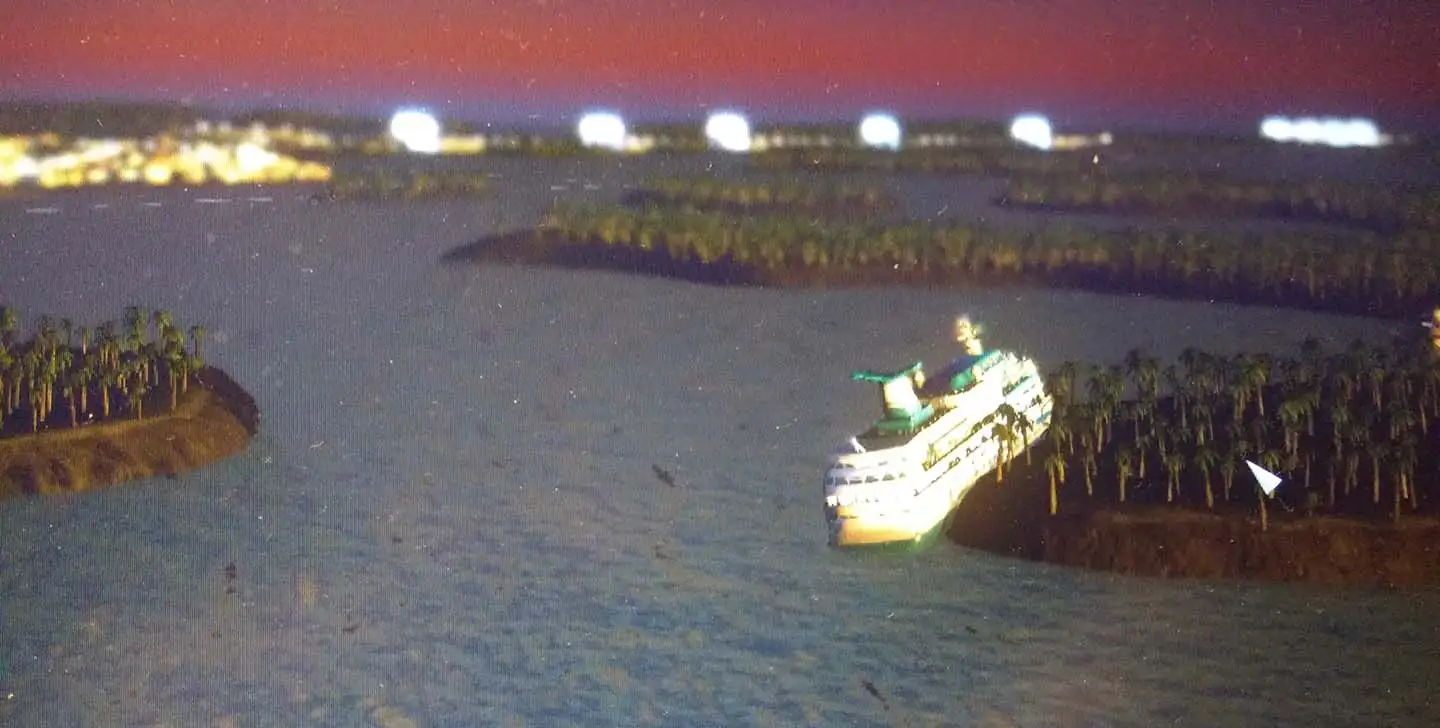
I didn’t think it was worth screenshotting but was worthing photographing with my phone. Yeah… I don’t know. Anyway, these poor saps stayed beached until they despawned.
In short: build up your attractiveness with unique buildings and parks and bring tourists in using the hub buildings. Make it an easy decision to use public transport, laying your lines so tourists use existing routes. And don’t forget to use the tourism specialisation and city policies to gives the city a boost.
I hope you found this helpful! Really, I’m answering all the questions I had when I was figuring out how tourism works in this game. I’d love to know what you think: if I’ve got anything wrong or missed key details. Or if there’s other aspects you’d like me to cover.
If you liked this content and want to buy any of the products I’ve talked about, you can support the site, donate to charity and (usually) save money all at the same time by using my links to Humble Bundle. Once you receive your product key, activate it on Steam, and you’re away! Thank you so much. Links are on the About page.